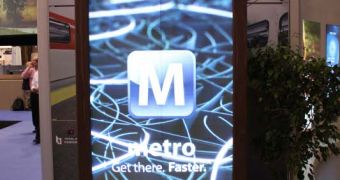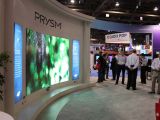Back at the beginning of June, during Infocomm in Las Vegas, Nevada, Prysm Inc. managed to make quite a few ripples on the large format display market by unleashing the TD1 tile screen. This display is based on the revolutionary LPD technology, elaborated in detail here, and is meant to play the part of building block in public, industrial and even enterprise display applications. Recently, we managed to get in contact with a company representative and were given some details on the actual nature of the panels, as well as their benefits compared to any other technologies currently available.
The TD1 is a 25-inch tile with an aspect ratio of 4:3 and a viewing angle of almost 180 degrees. Such panels are meant to be joined together by means of an image processor and several highly configurable frame options, both fixed and stackable. So far, this doesn't exactly sound much different from all the other solutions that other player commercialize. Fortunately, the new product has more than just one ace up its sleeve.
The actual specifications of the tile are the first asset. Besides their viewing angle of almost 180 degrees, their brightness is a quite striking 800 nits and their maximum refresh rate is no less than 240Hz. The other major asset is the wide range of practical implementations. To be more specific, integrators, architects and designers can put together whatever number of TD1 screens they wish and be pleased with how seamlessly they integrate with each other and the high resolution that the image processors themselves can output.
First off, one of said processors can handle up to 30 tiles and output a resolution of 1920 x 1080 pixels. Secondly, multiple such processors can be linked together in order to enable even larger screens of any resolution, shape and size. But the most noteworthy feature is that the TD1 can create the image all the way to the edges, leaving only a seam of 0.25mm, while the Edge Boost technology even brightens the seam itself. It is this that creates the illusion of a single, continuous panel. Add to that the 75% better efficiency (compared to other similar projects) and incredible endurance conferred by LPD's solid state components and internal health monitoring system. The result is a high-quality, high-resolution image of any dimensions and with a lifespan of at least 60,000 hours.
It should probably be noted that even after this time elapses, the individual displays will live on and retain at least 70% of their brightness. According to Prysm, the company is already working with many customers on a variety of projects and public applications and expects the first of them to begin servicing the populace within a few months.

 14 DAY TRIAL //
14 DAY TRIAL // 

